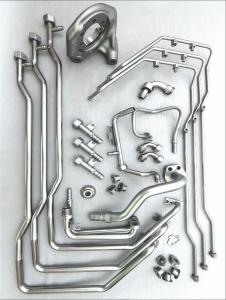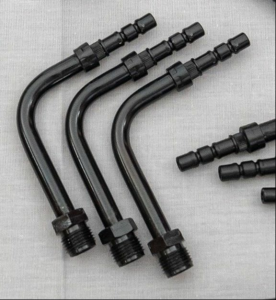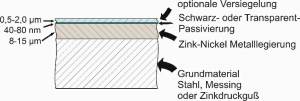Zinc-nickel coatings – alkaline process
Zinc-nickel coating has been established since the 1990s as a means of high-quality corrosion protection for steel. It is primarily used in automotive manufacturing, but it is also increasingly being used globally to meet high demands for corrosion protection.
During zinc-nickel electroplating, between 14% and 16% nickel is electrolytically incorporated into the coating as an alloying element at an electrolyte temperature of approx. 28°C.
To increase the corrosion protection, a transparent or black passivation layer is then applied to the zinc-nickel, with a thickness of approx. 60 to 80 nanometres.
The components can then be provided with a silicate-based or polymer-containing sealer to further improve scratch resistance and corrosion protection. (This is essential in the case of black passivation).
This results in an extremely long-lasting coating that exceeds the corrosion protection of conventional zinc coatings ten-fold – with the same thickness (e.g. 8-15 micrometres). Thanks to the good distribution of layer thickness, features such as threads are no problem.
Corrosion protection:
- Up to 240 h without zinc corrosion
- Up to 1000 h without base material corrosion in a neutral salt spray test
Standard examples:
- DIN 19598 – Fe//ZnNi8-15/An//T2
- Daimler Benz: DBL 8451.66
- DAF: WO 230
- Volvo: STD 121-0015 Y1500-3 bzw. 4
- MAN: M 3536 S bzw. SV
- VW: 13750 r642/r643
- Liebherr: LN 252-7
- Voss: WN 3006-1




